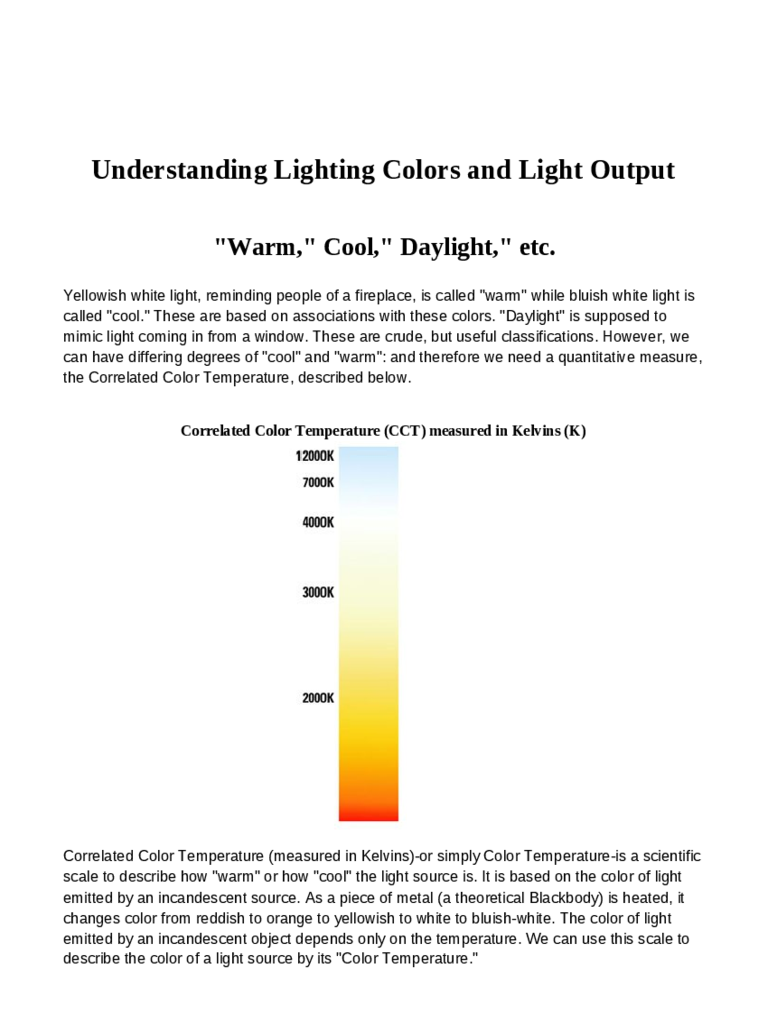Fillable Printable Understanding Lighting Colors and Light Output
Fillable Printable Understanding Lighting Colors and Light Output

Understanding Lighting Colors and Light Output

Understanding Lighting Colors and Light Output
"Warm," Cool," Daylight," etc.
Yellowish white light, reminding people of a fireplace, is called "warm" while bluish white light is
called "cool." These are based on associations with these colors. "Daylight" is supposed to
mimic light coming in from a window. These are crude, but useful classifications. However, we
can have differing degrees of "cool" and "warm": and therefore we need a quantitative measure,
the Correlated Color Temperature, described below.
Correlated Color Temperature (CCT) measured in Kelvins (K)
Correlated Color Temperature (measured in Kelvins)-or simply Color Temperature-is a scientific
scale to describe how "warm" or how "cool" the light source is. It is based on the color of light
emitted by an incandescent source. As a piece of metal (a theoretical Blackbody) is heated, it
changes color from reddish to orange to yellowish to white to bluish-white. The color of light
emitted by an incandescent object depends only on the temperature. We can use this scale to
describe the color of a light source by its "Color Temperature."

2
When we say a lamp has a Color Temperature of 3000 Kelvins, it means a glowing metal at
3000 Kelvins would produce light of about the same color as the lamp. Instead, if the metal is
heated to 4100 Kelvins, it will produce a much whiter light. Direct sunlight corresponds to about
5300 Kelvins while daylight, which has the blue from the sky mixed in, is typically 6000 Kelvins
or above. A standard incandescent lamp has a filament at 2700 Kelvins, and therefore (by
definition) a Color Temperature of 2700 Kelvins.
Lumens Vs. Watts Output
We often tend to think of a light bulb's brightness in terms of watts, because we have used the
same kind of bulb---incandescent---for more than a century. But this is misleading. Watts
measure the amount of electrical power that a light bulb consumes, but do not directly indicate
the brightness of the light that the bulb emits. Brightness is in fact measured in lumens
.
Why It Matters
As new types of bulbs move onto the market, it becomes more and more important
to base buying decisions on output in lumens rather than energy consumption in
watts. Fortunately, though, we can expect that as long as traditional incandescent
bulbs remain available, marketers will continue to describe the light output of other
kinds of bulb, such as compact fluorescents and LEDs, in terms of the light
produced by an incandescent bulb of a particular wattage.
What is a Watt?
A watt is a unit of power. According to Dictionary.com, it is "equivalent to one joule
per second and equal to the power in a circuit in which a current of one ampere
flows across a potential difference of one volt." In layman's terms, a watt is the

3
result of multiplying amperes by volts. In the case of electric light, it is the amount
of power used in one hour by the bulb. A 100 watt bulb uses 100 watts of power
every hour it is on, a 60 watt bulb uses 60 watts, and so on.
What is a Lumen?
The rating of a bulb in lumens tells you, quite simply, how bright it is. The PC
Magazine Encyclopedia states that "Lumens define 'luminous flux,' which is energy
within the range of frequencies we perceive as light."
Lumens and Watts
Most of us are so used to thinking of bulb brightness in terms of watts that we
forget that this only works when we're talking about the same kind of bulb. A
traditional 75 watt incandescent bulb will always be brighter than a 40 watt bulb.
But an18 to 25 watt compact fluorescent can deliver the same brightness (1,100
lumens) as a 75 watt incandescent bulb---making it much cheaper to use.
The Marketplace
To conserve energy, U.S and a number of European countries have banned or will
soon ban incandescent bulbs from domestic use, in favor of compact fluorescent
bulbs. This is because, as we've seen, compact fluorescents produce more
lumens per watt---in other words they are more efficient. LED bulbs are an even
more efficient technology. As these new products push aside traditional
incandescent bulbs, consumers will find it increasingly useful to think in lumens
rather than watts.



